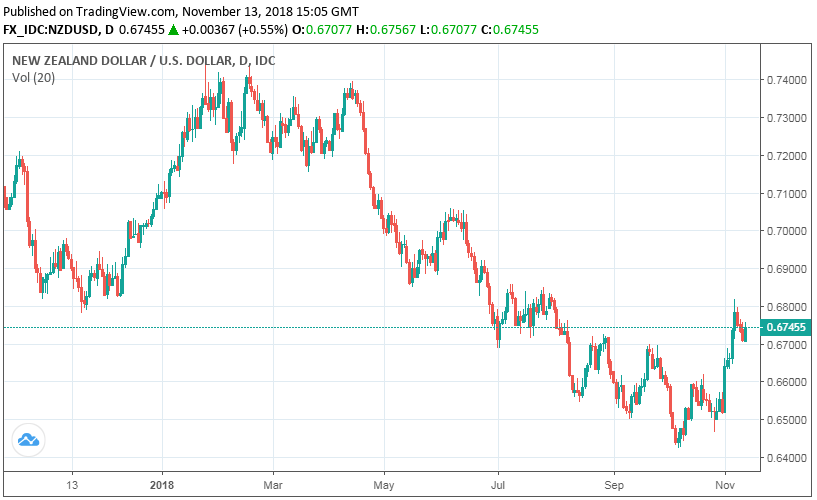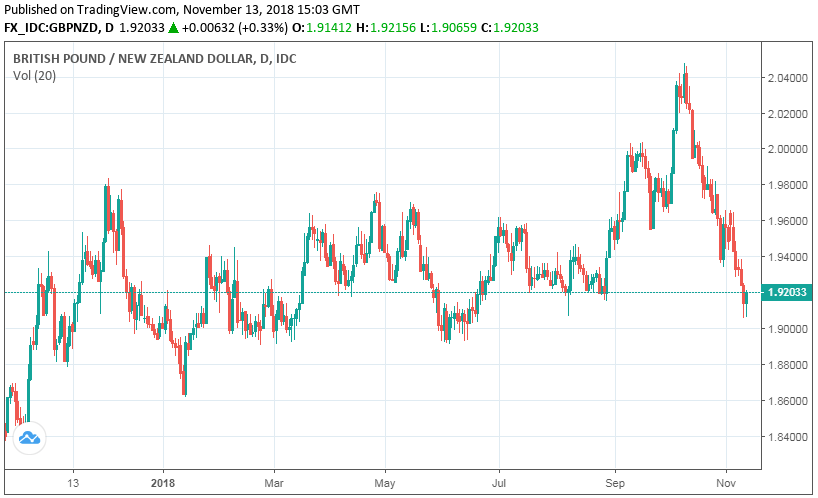New Zealand Dollar: Chinese Data to Dictate Direction Over Coming Days
- Written by: James Skinner

Image © Rafael Ben-Ari, Adobe Images
- NZD breaks higher following period of consolidation.
- But direction ahead depends on Wednesday's Chinese data.
- Positive figures could encourage further NZD squeeze higher.
The New Zealand Dollar rose Tuesday after two consecutive sessions of consolidation but its trajectory over coming days will depend largely on the tone of the latest Chinese industrial figures due out in the early hours of Wednesday.
Chinese Premier Li Keqiang told an audience in Singapore that China will seek to resolve trade disputes through negotiations and that the country remains committed to opening itself up to overseas firms.
Keqiang's comments encouraged hopes that Presidents Donald Trump and Xi Jingping may reach a deal to de-escalate the so called trade war between the U.S. and China at the G20 summit scheduled for the end of November.
This boosted "risk" assets and also lifted the New Zealand Dollar overnight given its commodity and China linkeages. The Kiwi currency is underwritten by New Zealand's agricultural commodity trade with China.
"The AUD and NZD strengthened this afternoon during a period where a lot of Chinese/US headlines were hitting the wires. The AUD is around 0.7215 and the NZD is near 0.6745," says Philip Brown, a bond market strategist at Commonwealth Bank of Australia.
However, the trajectory of the Kiwi Dollar over coming days will be determined as much by economic data emerging from China as it will headlines about the trade war.
Chinsese officials are set to release October's fixed asset investment and industrial production figures during the early hours of Wednesday.
"The softer October production PMI suggests industrial production might have ease slightly to 5.7%/yr. We anticipate year-to-date fixed asset investment growth to pick up further to 5.5%/yr because the higher October construction PMI showed fiscal stimulus has started to feed through," says Kristina Clifton, an economist at Commonwealth Bank.
Markets will scrutinise these figures closely for clues of any damage from President Trump's tariffs as well as looking for signs that the government's various stimulus packages are beginning to support the economy.
Consensus is for Chinese industrial production growth to have held steady at an annualised pace of 5.8% during October while fixed asset investment growth is seen picking up by 10 basis points to 5.5%.
So if CBA's Clifton is right in her predictions for the data then the actual numbers will come as a disappointment for the market and the Kiwi Dollar could suffer as a result.
Chinese industrial production growth has declined from 7.2% in February, the month before White House tariffs on Chinese steel and aluminium were announced, to just 6% in July when the levies were actually implented.
Meanwhile, fixed asset investment growth has slowed from 7.9% to just 5.5% over the same time period. The economy slowed during the third quarter, with GDP rising at an annualised pace of 6.5%, down from 6.6% previously.

Above: NZD/USD rate shown at daily intervals. Captures October - November recovery.
The New Zealand Dollar was quoted 0.53% higher at 0.6752 against the U.S. Dollar Tuesday and has risen 4% in the last month. It's down -4.6% for 2018.
The Pound-to-New-Zealand-Dollar rate was 0.40% higher at 1.9214 but has fallen nearly 5% in the last month, leaving its 2018 gain at just 1.1%.

Above: GBP/NZD rate shown at daily intervals. Captures October - November decline.
Tuesday's price action leaves the New Zealand Dollar in the middle of its sixth week of gains.
The currency has recovered handsomly since early October, when the outlook for Kiwi growth and interest rates was at its worst. Last week the Kiwi was boosted by a labour market report showing unemployment falling to its lowest level since the financial crisis.
"Some better employment 3Q18 employment data and a slightly more positive RBNZ has seen quite a substantial steepening of the NZD money market curve, which has helped the NZD," says Chris Turner, head of currency strategy at ING Group. "[This week] we expect NZD to largely trade alongside, if not slightly outperform its AUD peer, both being driven by Chinese data."
This was after official data showed inflation rising to 1.9% during the third-quarter, placing the 2% to 3% target band of the Reserve Bank of New Zealand (RBNZ) within sight. Earlier data also showed the Kiwi economy growing much faster than was previously thought during the second-quarter.
Before all of that markets had been fretting about the possibility of a rate cut being delivered by the Reserve Bank of New Zealand during the months ahead, after the central bank began warning back in July that such a move is possible.
However, November's RBNZ statement confirmed that data released over the course of October has cast the economy in a less troubling light than many had previously seen it.
Advertisement
Bank-beating exchange rates. Get up to 5% more foreign exchange by using a specialist provider to get closer to the real market rate and avoid the gaping spreads charged by your bank when providing currency. Learn more here
Kiwi Interest Rate Outlook Brightening?
The bank still says it is unlikely to raise its interest rate until well into the 2020 year but it has now stopped warning about the potential for an imminent interest rate cut, offering some support to the Kiwi.
"The driver of this less dovish view came from the key data developments since August, with materially higher-than-expected Q2 GDP and Q3 CPI out-turns. We expect that growth will accelerate modestly and be sufficient to see capacity pressures persist and unemployment stay low," says Robin Clements, an economist at UBS Group.
If that is the case and the data remains favourable over coming weeks then there could be scope for the Kiwi currency to continue its recent outperformance. Particularly if markets grow to doubt the RBNZ's suggestion that it will keep its interest rate at a record low for at least another 18 months.
The RBNZ has held its interest rate at 1.75% for two years now, as other central banks across the globe have raised theirs, particularly those in North America.
This had created an incentive for investors to sell New Zealand Dollars and to buy U.S. Dollars, Canadian Dollars and a handful of other currencies instead.
Advertisement
Bank-beating exchange rates. Get up to 5% more foreign exchange by using a specialist provider to get closer to the real market rate and avoid the gaping spreads charged by your bank when providing currency. Learn more here




